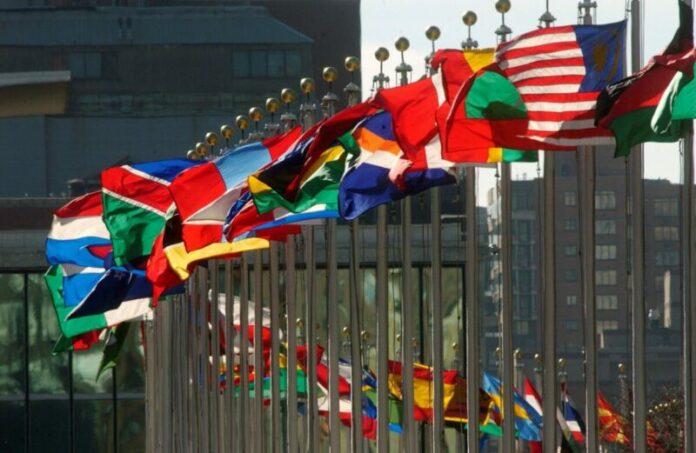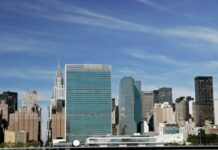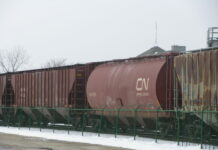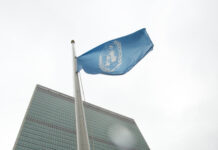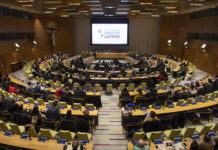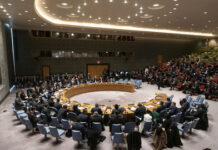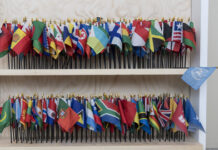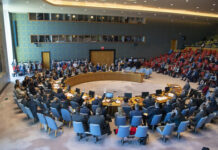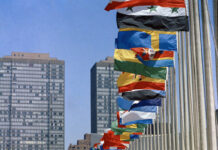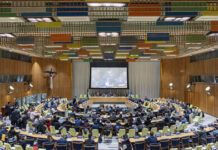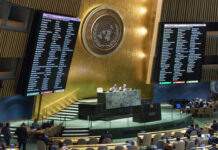Gernot Laganda: There are three key drivers of hunger. The first one is conflicts. Then we have climate extremes, and then we have economic shocks and climate shocks such as droughts, storms, floods, heat waves. They cause increasing losses and damages to the systems that produce food and that bring it to people’s tables.
But then we are equally worried about lower-level climate variations and stresses. They play a role also in chronic hunger. We’re talking about irregular rainfall, changing seasons, rising salinity in soils and groundwater, shifts in pest infestations, heat stress in livestock, so all these things are making households more vulnerable.
In such strained conditions, chronic hunger can then turn into a life-threatening acute situation very quickly, even when smaller shocks hit, so the second element that does not necessarily get as much airtime as the climate disasters, is the climate stresses and the less visible impact.
And then there’s a third pathway through which the climate crisis drives hunger, which is via displacement, social tensions, and conflict. Climate impacts aggravate resource scarcity. They displace people, and that can then fuel social and political tensions. Once these tensions erupt in violence and conflict, people become extremely vulnerable and unable to manage any other risks in their livelihoods.
When you look at the top 20 countries that are currently classified as the most vulnerable to the effects of climate change and the least able to adapt, then more than half of them are in conflict. And in those countries where we have people that experience both climate shocks and conflict and violence, hunger is more severe there.
UN News: In the paths that you mentioned, are there solutions? Are there any innovations out there and is there a way to implement those solutions?
Gernot Laganda: When you look at the types of solutions that you find in WFP country programs, there is one important element which is about anticipation and preparedness. Most climate disasters are predictable. The science used to forecast them is increasingly reliable. So, if we make effective use of forecasts, risk analysis, early warning information, then it is possible to put in place the actions and the financing that’s needed to act before a climate disaster hits and not wait until people are already in life threatening situations.
When a particular weather forecast tells us that climate hazard is about to hit, then we aim to release early warning advisories, cash transfers and other services in partnership with governments and local partners. And with these resources vulnerable people can prepare for these shocks and mitigate their impacts.
Another element that’s important is financial protection and risk sharing. Not many people know this, but WFP is the one UN organization that applies climate risk insurance solutions at scale. So far in 2023, we’ve connected five million people with climate risk insurance solutions and services in 26 countries, and in areas affected by droughts. Draughts and storms insurance pay-outs have already benefited 500,000 people.
So, there is not only an immediate opportunity to go to a bigger scale with these insurance solutions, there’s also an opportunity to strengthen the capacities of governments so that they understand which risk financing solutions work best in which countries. And then lastly, I would say what’s really important in the current state of the climate crisis, we need a surge in locally-lead climate change adaptation and disaster risk reduction projects.
In WFP, for example, we have worked for decades with community-based resilience programmes which help to restore degraded ecosystems and infrastructure, help people adopt regenerative farming practices, and increase natural resource efficiency. Over the past five years, these programs have rehabilitated around 1.7 million hectares of land, which is now not only delivering local adaptation services but also global carbon benefits. So those are the three elements that I would mention: anticipation and preparedness, ramping up financial protection and then locally-lead disaster risk reduction and climate change adaptation.
UN News: You mentioned insurance. Could you explain a little bit more how this insurance works? What kind of an instrument is that?
Gernot Laganda
There are two types of insurance that we work with. The first one is micro insurance, which is when a smallholder farmer household is the insurance policy holder. And just like we can distribute cash or food or vouchers, we can also distribute insurance coverage in our large community-based resilience programs. The second type of insurance coverage is where WFP itself is buying insurance against catastrophic drought demands, for example, through an instrument that’s called the African Risk Capacity (ARC).
Last year, both micro- and macro-insurance have reached 3.8 million people in 21 countries. Following rainfall seasons in Mali, Burkina Faso and The Gambia, these programs have triggered $15 million in pay-outs which we have then implemented as early food and cash assistance. So, this has basically complemented the public funding for emergency response with insurance-based mechanisms and thereby reduced the humanitarian financing gap that we were facing.
Micro insurance is really, I would say, a long-term contribution to de-risking food systems. So, if smallholder farmers have access to insurance protection, then they also have better access to financial services. They have a different savings behaviour. They can take more risks. For example, switching into different crop types, diversifying crops. I would call it a longer-term adaptation investment.
If we work with sovereign insurance and if we make climate risk insurance products work for the humanitarian sector, then, we can really crowd in additional financing, private sector financing, into what is otherwise a publicly funded humanitarian response system.
This is where then we try to address this element of usually not enough funding being available after climate disasters to meet all the humanitarian needs that are out there.
There are existing solutions. We need to tailor these solutions to the different risk context.
UN News: This kind of solutions and many others are going to be discussed during the upcoming COP 28 climate conference. What are your expectations? What deliverables do you think this conference can bring for the further advancement of such solutions and many others in order to mitigate consequences of climate change?
Gernot Laganda: One thing we really hope to see at this particular Conference of Parties are greater commitments for climate action in fragile and vulnerable settings. We have had decades now where the temperature curve has really kept climbing, while adaptation financing was often too little, too late.
So many communities on the frontlines of the climate crisis now find themselves in this era of loss and damage. They do not have time until we have phased out fossil fuels. Until we have more adaptation funding available, until we have re-defined multilateral climate funds. These communities are now facing clear and present danger, and it’s a matter of being hit by these climate extremes in a few months from now and not just a few years from now.
For us, a big metric at this COP is whether we see clear commitment to ramp up climate protection for the most vulnerable people in the most vulnerable settings. This can be measured also by a better balance in climate finance allocations and climate finance flows.
WFP is supporting in this context the COP28 Declaration on Climate Relief, Recovery and Peace which will be launched on the 3rd of December, which is Relief, Recovery and Peace Day. And we will hope that this declaration will increase political visibility of this issue and then highlight the need to ramp up climate action in fragile context, because these are the contacts that have the escalating humanitarian needs that at the current point in time cannot be met with the available humanitarian financing.
We hope that the Loss and Damage Fund that has been negotiated will be operational at the same time. For us, the litmus test for climate justice is in protection at the local level. It is not enough, I think, to transfer funding from 1 country to another. For us, the metric for climate justice is protection before lives are in danger and before the international humanitarian system needs to come in and help save lives. We hope that this Loss and Damage fund will be established. We hope that it focuses on fast, locally-aimed action in order to protect the most vulnerable.
UN News: What do you think is the role of an individual in this process? How can an ordinary person be part of climate action?
Gernot Laganda: We of course there are certain things that everybody can do individually, in their own families. It starts, of course, from realizing how individual action is connected with the global climate. For example, the food that we put our put on our tables matters to the climate in various ways. It also, I think, relates to learning more about the role of food loss and waste. If taken together, food loss and waste – if they were a country – would be the third largest greenhouse gas emitter!
So, it starts from taking little decisions to make sure we do not waste our food. That we eat things that have a low carbon footprint. We also should be ready and support climate action through local institutions, which are really anchored in the space where climate justice happens. Depending on where people live, there are various ways of engaging in climate action.
Source of original article: United Nations (news.un.org). Photo credit: UN. The content of this article does not necessarily reflect the views or opinion of Global Diaspora News (www.globaldiasporanews.com).
To submit your press release: (https://www.globaldiasporanews.com/pr).
To advertise on Global Diaspora News: (www.globaldiasporanews.com/ads).
Sign up to Global Diaspora News newsletter (https://www.globaldiasporanews.com/newsletter/) to start receiving updates and opportunities directly in your email inbox for free.


